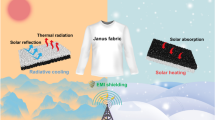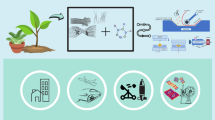Abstract
The dimensional, some physical and thermal comfort properties of the plain knitted fabrics having modal viscose microfibers in three different stitch lengths are investigated in comparison with the similar fabrics having conventional modal viscose fibers. The fabrics made from microfibers and conventional fibers exhibit different dimensional properties. The stitch density results and the dimensional constants calculated at the fully relaxed state reveal that the fabrics with microfibers tend to have lower shrinkage tendency than those with conventional fibers. The statistical results show that the fiber type (or fiber fineness) and the stitch length affect the some physical properties and all of the thermal comfort properties of the fabrics significantly. The bursting strength values of the fabrics with microfibers are observed to be slightly higher than those of the fabrics with conventional fibers. However, the difference between the bursting strength values of these fabrics is found to be statistically unimportant. The fabrics with microfibers reveal lower thickness and air permeability and, higher pilling tendency than those with conventional fibers. It is also observed from the thermal comfort results that the fabrics made from microfibers have higher thermal conductivity, thermal absorptivity and maximum heat flux values and, lower thermal resistance and thermal diffusivity values. Because of the higher thermal absorptivity and maximum heat flux values, the fabrics from microfibers provide cooler feeling when compared with those from conventional fibers.
Similar content being viewed by others
References
S. Mukhopadhyay and G. Ramakrishnan, Text. Prog., 40, 1 (2008).
S. R. Matic-Leigh, National Textile Center Annual Report, 30, (1993).
A. Karolia and N. Paradkar, J. Text. Assoc., 65, 31 (2004).
A. Karolia and N. Paradkar, Ind. Text. J., 116, 81 (2005).
J. Srinivasan, G. Ramakrishnan, S. Mukhopadhyay, and S. Manoharan, J. Text. Inst., 98, 31 (2007).
G. Ramakrishnan, B. Dhurai, and S. Mukhopadhyay, Journal of Textile and Apparel Technology and Management, 6, 1 (2009).
J. Srinivasan and G. Ramakrishnan, Asian Text. J., 13, 78 (2004).
P. J. Doyle, J. Text. Inst., 44, 561 (1953).
D. L. Munden, J. Text. Inst., 50, T448 (1959).
M. S. Burnip and M. N. Saha, J. Text. Inst., 64, 153 (1973).
H. N. Yoon and A. Buckley, Text. Res. J., 54, 289 (1984).
B. V. Holcombe and B. N. Hoschke, Text. Res. J., 53, 368 (1983).
I. Frydrych, G. Dziworska, and J. Bilska, Fibres & Textiles in Eastern Europe, 39, 40 (2002).
A. Das, V. K. Kothari, and A. Sadachar, Fiber. Polym., 8, 116 (2007).
M. Bona, “Textile Quality, Physical Methods of Product and Process Control”, Textilia, Italy, 1993.
J. O. Ukponmwan, Text. Prog., 24, 1 (1993).
P. J. Weedall and L. Goldie, J. Text. Inst., 92, 379 (2001).
L. Hes, M. D. Araujo, and V. V. Djulay, Text. Res. J., 66, 245 (1996).
M. Yoneda and S. Kawabata, Journal of the Textile Machinery Society of Japan, 31, 79 (1985).
M. Yoneda and S. Kawabata, Journal of the Textile Machinery Society of Japan, 34, 1 (1988).
L. Hes, Int. J. Cloth. Sci. Technol., 11, 105 (1999).
R. L. Barker, Int. J. Cloth. Sci. Technol., 14, 181 (2002).
R. S. Rengasamy, B. R. Das, and Y. B. Patil, J. Text. Inst., 100, 507 (2009).
M. J. Pac, M. A. Bueno, M. Renner, and S. E. Kasmi, Text. Res. J., 71, 806 (2001).
Author information
Authors and Affiliations
Corresponding author
Rights and permissions
About this article
Cite this article
Gun, A.D. Dimensional, physical and thermal comfort properties of plain knitted fabrics made from modal viscose yarns having microfibers and conventional fibers. Fibers Polym 12, 258–267 (2011). https://doi.org/10.1007/s12221-011-0258-2
Received:
Revised:
Accepted:
Published:
Issue Date:
DOI: https://doi.org/10.1007/s12221-011-0258-2




